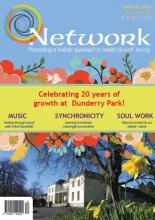You are here
Home › Articles › Our Organic Super Computers: Exploring the power of belief and associationOur Organic Super Computers: Exploring the power of belief and association
by:
Ken Loftus
Published:
Monday, June 8, 2015

Every second our brains have the potential of having 17.2 trillion actions. The 86 billion neurons in an average human brain that work in conjunction with each other, forming memories, associations, reactions and emotions, work on less energy than a light bulb.
This information isn’t just to wow our inner scientist, it is to see how fantastic our brains are and to see how they work as the most complicated organ in our body. Our ‘Organic Super Computers’ work in many deep intricate ways, creating our consciousness while housing our unconsciousness, creating new memories, while holding onto old ones, and helping us feel the happiest emotions, and also the darker ones. The main aspects this article focuses on are the following Organic Super Computer skills of association, patterns, and belief systems and how they are tied into our thoughts and emotions.
Most of us, at probably more than once in our lives, have scolded ourselves for having a thought or a certain reaction to a situation. Perhaps we mixed up a friend’s name, or we thought of an ex-partner when we felt we should be thinking of the current love of our life. We may have then looked inward and got angry at ourselves for such a “stupid mistake” or having a “bad thought”. This article will help us see our brains as the Organic Super Computers that they are, instead of a part of us that at times we dislike or even hate for the thoughts and emotions it gives our consciousness.
We will look at how thoughts that are tagged with emotions can be triggered by our senses and our brains and enter our consciousness and these thoughts, depending on our belief systems, can bring with them very damaging emotions, and further, downward spiralling thoughts, that could then lead to deeper emotions like depression, anxiety, and anger.
We will look at Mindfulness and therapeutic applications of how one can use it to accept and be aware of our thoughts and emotions. To help us acknowledge and redirect our thoughts and emotions, using our five ‘always-on’ senses and our consciousness.
This article will also look at how Cognitive Behavioural Therapy can be used to challenge our beliefs with facts to help reprogram our reactions to external and internal events. To help reprogram our Negative Automatic Thinking to Positive Automatic Thinking that can occur in nanoseconds due to our Organic Super Computer brains.
The speed of our Organic Super Computer Brains create lightening quick associations between internal and external stimuli and events. For example, we walk down the street, and a song drifts out from a shop, the ears pick up the sound waves and send the signal up the audio nerve to the brain, the brain recognises it is a song, and scans our memory banks to see if we know it. The brain gets a hit! This particular song was chosen by you and your first love as “Your Song”. Then the association continues and the thoughts start passing through the filter between the unconscious and conscious and you are suddenly aware that you are thinking about a past love that you haven’t thought of in years.
What do we then do with those thoughts? Perhaps we realise we have a small smile on our face as we dwell on a moment of a past happy memory, and continue our walk, or perhaps we start feeling a sadness growing because that ex-love broke our heart. The fact is that the brain will activate those memories and thoughts, and send some to the consciousness, no matter if we like them or not. What we call our consciousness, our Self, or our Mind, then labels these thoughts with values, such as ‘bad’ or ‘good’. With these labels in place, we may then punish ourselves for having a ‘bad’ or ‘wrong’ thought. This is when we focus on consciously accepting that the thoughts are there and tell ourselves that it is OK to have them. That when we sense an emotion in us, an emotion we do not want, and we then focus on redirecting away from these thoughts and with them the emotions. Perhaps it sounds easier said than done, but we will see in the Mindfulness and CBT section exercises to help make it a little easier.
Do not do the following; do NOT think of Mickey Mouse. Do not think of Mickey Mouse, his big black ears, his white gloves and squeaky voice. Do not think of him at all! But there he is - a mouse that has been around us for decades. When we imagine Mickey Mouse or our ex-partner our brain hasn’t done something wrong, it has done exactly what it is built to do. Your brain took in each word and in nanoseconds, with association, processed the image and meaning of each word. Your brain then sent to the consciousness how all these words tie together to give a meaning to them, hence Mickey Mouse appearing.
Unfortunately for us the brain does not discriminate between what we label, as Good or Bad thoughts. With the same way Mickey Mouse popped into our mind even though we saw ‘do NOT’, that song that reminded us of our past love activates too. We may not want our brains to associate and connect to painful memories, but it will happen. Accepting this fact can help us take a breath when a thought jumps into our consciousness, offer ourselves some self-compassion, and redirect to a more positive thought.
Did you drive today? How many times did you change gears? Did you have your hands at the ‘10 and 2’ position on the steering wheel? For drivers, when we first start to learn we focus so much on where are hands are, what gear we’re in, but soon we’ve slipped into unconscious competence and we are unaware of what we know, and are driving on nearly full automatic leaving our conscious mind to focus on other tasks for the day or to be aware that there are new road works to avoid. Like our associations, our brain will create patterns around any repeat behaviour, no matter if it then creates or tags on emotions we wish it didn’t. This can be especially dangerous around anxiety and panic. It can get to a place where we are anxious about feeling anxious, instead of accepting that we have some anxiety in our system, for example, public speaking. If one gets anxious around public speaking, it may be due to a deep belief inside us that we believe the audience should not laugh at us, as laughing at us is wrong. As we’ve repeated that thought over and over, it has slipped into a pattern, and now we don’t even know the reason why we’re anxious in front of a crowd anymore, we now get anxious over feeling anxious, and don’t delve further.
Mindfulness can be a fantastic tool used with our Organic Super Computer brains. Mindfulness is to be aware of the psychological events of the brain, of the thoughts and emotions. Imagine our brain flowing like a river, and thoughts and emotions are debris floating down the river, like small leaves and big great logs that are hard to avoid if we were in the middle of that river. Mindfulness tells us that we can be standing at the edge of the river, observing the debris, instead of being in the middle of the river being hit by the debris, or overwhelmed by the large log that is flowing towards us. Breathing can be a brilliant kinesthetic exercise to help us become aware of thoughts and emotions. One such guided exercise can be - we sit, we close our eyes, and we focus on our breathing, we consciously think about inhaling and exhaling, we think about the air feeling cooler on the inhale, we think about that small gap between inhaling and exhaling, and when our mind wanders, because it will, we become aware that it has, we label it as ‘thinking’ and we redirect back to our breathing. We can focus, while breathing, on our Hearing sense too, focus on the furthest away sound you can hear, and then focus on the closest sound you can hear, it could be your own breathing. When your mind wanders, become aware of it, label it as ‘thinking’ and redirect back to the last sound you were focusing on.
Practicing this breathing exercise of thoughtful awareness will prepare your organic super computer brain better for when a thought enters your mind that brings with it low, heavy emotions that you don’t want to have in that moment. We close our eyes, breathe, acknowledge and redirect.
There are many therapies created around the umbrella term of Cognitive Behavioural Therapy, not just one over all therapy. The Organic Super Computer Brain creates belief systems in our psyche, and it is our brain that is connecting with these beliefs that then can bring up emotions. For example, if I believe my friend should not insult me, because we are friends, and then he insults me, it will hurt. If I was to reprogram that belief with a fact that my friend can indeed insult me, I just hope he doesn’t, there may be a hurt there, but it will not be as severe. Our brains can work better if we use facts instead of beliefs when dealing with situations, especially in relationships.
We can also map out our thoughts and emotions together with our actions and our physical sensations to help recognise what is going on inside. Such as: When I think of an exam coming up, my emotions would be stress, my actions could be nail biting and pacing, and my physical sensation could be a tightening of my gut. I then can look at what I can directly try to change, such as consciously going for a nice stroll instead of pacing, while redirecting my thinking to the tea break I’ve planned after my exam, and with some deep breathing to help the tense stomach, I should then also realise my emotions are moving to a more lighter shade.
So next time your ex pops into your mind, or the painful stress of an exam enters your thoughts, or a sadness flows into your consciousness, take a breath, take a moment, and remember, our brains are fantastic, complicated, multi layered, versatile, resilient yet fragile, lightning quick organs, they create and deliver our hopes, dreams and fears, sometimes all in one moment. If we treat ourselves with compassion, and understanding our brains can be our best friend and most powerful ally.
About the author:
Ken has worked in and around mental health and child protection services for over 14 years, in the last several years Ken has been a counsellor and psychotherapist working with teenagers and adults, in his private practice. Ken’s integrative style includes combining the meditative sides of Mindfulness and the solution focused counselling styles.
Find out more via www.loftuscounselling.com or 086 389 2294
Related Links:
In Issue:
Latest Issue
Upcoming Events
-
17/04/2020 to 26/04/2020
-
18/04/2020
-
23/04/2020
-
15/05/2020 to 23/05/2020
-
16/05/2020 to 17/05/2020
Recent Articles
Article Archive
- November 2011 (2)
- January 2012 (3)
- February 2012 (2)
- March 2012 (2)
- April 2012 (4)
- May 2012 (4)
- June 2012 (1)
- July 2012 (3)
- August 2012 (2)
- October 2012 (2)

